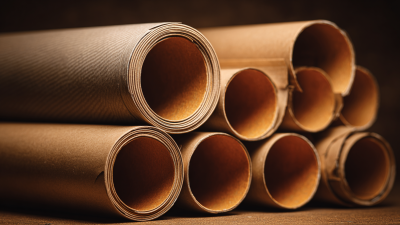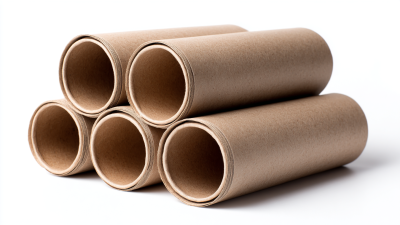Why Cardboard Tubes Are the Ultimate Solution for Eco Friendly Packaging
In recent years, the global push for sustainable packaging solutions has led to a significant increase in demand for eco-friendly materials. According to a report by Smithers Pira, the global sustainable packaging market is projected to reach $500 billion by 2027, reflecting a growing consumer preference for environmentally responsible options. Among these solutions, cardboard tubes have emerged as a leading choice due to their recyclability and versatility.

These cylindrical packages not only reduce plastic waste but also offer enhanced protection for products such as cosmetics and gourmet foods. With a reported recycling rate of over 70% in many regions, cardboard tubes provide a compelling alternative that aligns with the sustainability goals of businesses and consumers alike. As industries strive to mitigate their environmental impact, the adoption of cardboard tubes is poised to play a pivotal role in the future of eco-friendly packaging.
What Makes Cardboard Tubes an Eco-Friendly Choice for Packaging
Cardboard tubes have emerged as a game-changer in the realm of eco-friendly packaging, primarily due to their renewable nature and recyclability. According to the American Forest & Paper Association, cardboard and paper products comprise over 70% of the recycled material in the U.S., highlighting their role in reducing landfill waste. The production process of cardboard tubes also boasts a significantly lower carbon footprint compared to plastic alternatives; a study from the Ellen MacArthur Foundation indicates that switching to paper packaging could reduce greenhouse gas emissions by up to 60%.
Additionally, cardboard tubes offer versatility across various industries, from cosmetics to food. The global sustainable packaging market is anticipated to grow from $280 billion in 2020 to over $500 billion by 2027, as reported by Smithers Pira. This shift is driven by both consumer demand and regulatory pressure for more sustainable practices. The inherent strength and durability of cardboard tubes not only protect products effectively but also represent a conscious choice that aligns with the increasing emphasis on sustainability in packaging solutions.

The Manufacturing Process: Sustainable Practices in Cardboard Tube Production
The manufacturing process of cardboard tubes showcases a commitment to sustainable practices that align with eco-friendly packaging solutions. Unlike traditional plastic packaging, cardboard tubes are made from renewable resources, primarily recycled paper. The production begins with responsibly sourced raw materials, where recycled cardboard is processed into pulp. This pulp is then formed into long sheets, which can be cut to the desired dimensions for tube production, minimizing waste and energy consumption.
Furthermore, the drying and shaping processes are designed to use less water and energy compared to other packaging materials. Many manufacturers employ innovative techniques such as water-based adhesives and eco-friendly inks, ensuring that the entire production cycle maintains a low environmental footprint. By prioritizing recyclable and biodegradable materials, the cardboard tube industry is making strides toward a more sustainable future, demonstrating that packaging can be both functional and environmentally responsible.
Comparison of Eco-Friendly Packaging Solutions
Innovative Uses of Cardboard Tubes in Various Industries
 Cardboard tubes have emerged as a versatile and sustainable packaging solution, finding innovative applications across various industries. In the cosmetics sector, for instance, brands are increasingly adopting cardboard tubes for packaging lip balms and lotions. According to a report by Smithers Pira, the global cosmetic packaging market was valued at approximately $24 billion in 2020, with a notable shift towards sustainable materials. Cardboard tubes not only reduce plastic waste but also offer an aesthetic appeal that resonates with environmentally conscious consumers.
Cardboard tubes have emerged as a versatile and sustainable packaging solution, finding innovative applications across various industries. In the cosmetics sector, for instance, brands are increasingly adopting cardboard tubes for packaging lip balms and lotions. According to a report by Smithers Pira, the global cosmetic packaging market was valued at approximately $24 billion in 2020, with a notable shift towards sustainable materials. Cardboard tubes not only reduce plastic waste but also offer an aesthetic appeal that resonates with environmentally conscious consumers.
In the food industry, cardboard tubes are gaining traction for packaging snacks and other products. The Paper and Paperboard Packaging Environmental Council (PPEC) suggests that using paper-based packaging can reduce CO2 emissions by up to 30% compared to plastic alternatives. This shift is reflected in increased consumer demand for packaging solutions that highlight recyclability and sustainability. Additionally, manufacturers can leverage these tubes for branding, utilizing printed designs that enhance shelf appeal without compromising environmental responsibilities.
Tips: When considering cardboard tubes for packaging, ensure that the materials used are sourced from responsibly managed forests. Also, evaluate the lifecycle of the packaging solution to maximize recyclability. Exploring customization options can further align your product with eco-friendly branding initiatives.
Comparing Environmental Impact: Cardboard Tubes vs. Traditional Packaging Options
The environmental impact of packaging materials has become a pressing concern in recent years. In comparing cardboard tubes to traditional packaging options, such as plastic and Styrofoam, it becomes clear that cardboard tubes emerge as a significantly more sustainable choice. Unlike plastic, which takes hundreds of years to decompose and often contributes to ocean pollution, cardboard tubes are made from renewable resources and can be fully recycled or composted after use. This rapid biodegradability dramatically reduces their footprint in landfills, reinforcing the case for eco-friendly practices in packaging.
Furthermore, traditional packaging options often involve multiple layers and components that complicate recycling processes. In contrast, cardboard tubes are simple in design and made from a single material, making them easier to recycle. Many manufacturers have begun reusing reclaimed cardboard, further decreasing the demand for new resources. This emphasis on circularity not only extends the lifecycle of materials but also aids in reducing the overall carbon emissions associated with production. Ultimately, the choice of using cardboard tubes reinforces a commitment to sustainability, encouraging businesses to adopt greener alternatives that benefit the planet.
Tips for Transitioning to Cardboard Tube Packaging for Your Business
Transitioning to cardboard tube packaging can be an effective way for businesses to enhance their sustainability efforts while appealing to environmentally conscious consumers. Start by evaluating your current packaging methods and identifying products that could benefit from a switch to cardboard tubes. Consider the dimensions and weight of your items, as well as the protection they require during shipping and handling. Cardboard tubes not only provide robust durability but also offer a unique aesthetic that can set your brand apart in the marketplace.
Next, research suppliers who specialize in eco-friendly cardboard materials and custom tube designs. Collaborating with these suppliers can help you find the right type of cardboard that meets both your functional and branding needs. It’s also important to communicate the benefits of your new packaging to your customers, highlighting the reduced environmental impact. Finally, test the new packaging with a small batch of your products to gather feedback and make any necessary adjustments before a full-scale launch. This trial run can ease the transition and ensure that the cardboard tubes perform as expected.
Related Posts
-

Exploring Market Trends and Opportunities for Cardboard Tubes at the 138th Canton Fair in 2025
-

7 Innovative Cardboard Packaging Solutions That Will Transform Your Supply Chain
-

7 Best Reasons to Choose Cardboard Tube Boxes for Your Global Packaging Needs
-

Essential Guide to Cardboard Postal Tubes: Choosing the Right Type for Your Shipping Needs
-

5 Essential Tips to Maximize Your Sourcing Strategy for Carton Tubes
-

What Are Cardboard Postal Tubes and How Do They Benefit Your Shipping Needs?